
MathWorks Confirms Cyberattack, User Personal Information Stolen
MathWorks Confirms Cyberattack: User Personal Information Compromised
The digital landscape is a challenging frontier, and even established technology powerhouses are not immune to the relentless tide of cyber threats. Today, we delve into a significant security incident that has impacted MathWorks, Inc., the esteemed developer behind leading software like MATLAB and Simulink. The company has officially confirmed a cyberattack leading to the theft of sensitive personal information from its user base. This incident underscores the persistent dangers in our interconnected world and serves as a critical reminder for all organizations to fortify their digital defenses.
The Breach: What We Know
MathWorks, Inc. publicly announced that it was the target of a cyberattack compromising user data. While the exact number of affected individuals remains undisclosed, the company has begun notifying those whose personal information was stolen. This notification process is crucial for transparency and enables affected users to take immediate protective measures. The incident highlights a common tactic used by malicious actors: targeting high-value data repositories within organizations perceived to have extensive user bases and valuable intellectual property.
Impact on Users
The confirmation of stolen personal information is a grave concern for MathWorks users. Depending on the specific data categories compromised, users could face a range of risks, including:
- Identity Theft: Malicious actors often leverage stolen personal data to open fraudulent accounts, obtain loans, or file false tax returns.
- Phishing and Social Engineering: With access to personal details, attackers can craft highly convincing phishing emails or social engineering attempts to extract further sensitive information or deploy malware.
- Account Takeovers: If credentials were part of the breach, users’ accounts on other platforms (especially if they reuse passwords) are at heightened risk.
- Financial Fraud: Depending on the type of financial information potentially exposed, users could become victims of direct financial fraud.
MathWorks’ Response and Remediation Actions
In adherence to standard data breach protocols, MathWorks has stated they discovered the security incident and have been in the process of notifying affected individuals. While specific technical details regarding how the breach occurred are not yet publicly available, a responsible corporate response typically involves:
- Incident Response and Forensics: A thorough investigation to identify the root cause of the breach, the extent of data exfiltration, and the vulnerabilities exploited.
- System Hardening: Implementing immediate patches (if a specific vulnerability like CVE-PENDING was exploited, although none has been announced for this incident), reconfiguring security settings, and strengthening network perimeters.
- Enhanced Monitoring: Increasing vigilance over network activity and user accounts for any suspicious behavior.
- Communication with Affected Parties: Providing clear guidance to users whose data may have been compromised, including recommendations for steps they can take to protect themselves.
- Regulatory Compliance: Fulfilling legal obligations for data breach notification in all relevant jurisdictions.
Steps for Affected Users and General Cybersecurity Best Practices
If you are a MathWorks user, it is imperative to take proactive steps to protect yourself. Even if you haven’t received direct notification yet, adopting robust cybersecurity practices is always advisable.
- Monitor Your Accounts: Regularly review credit reports, bank statements, and other financial accounts for any suspicious activity. Consider placing a fraud alert or credit freeze with credit bureaus.
- Enable Multi-Factor Authentication (MFA): Always use MFA wherever available, especially for critical accounts. This adds a crucial layer of security beyond just your password.
- Change Passwords: Immediately change your MathWorks password. More importantly, if you have reused that password on other online services, change those passwords as well. Use strong, unique passwords for every account.
- Be Wary of Phishing: Expect a potential increase in sophisticated phishing attempts. Be extremely cautious of unsolicited emails or messages, especially those requesting personal information or prompting you to click on links. Verify the sender and purpose independently.
- Update Software: Ensure your operating systems, browsers, and all software are kept up to date with the latest security patches.
- Review Privacy Settings: Periodically review privacy settings on all online platforms to limit the amount of personal information that is publicly accessible.
Conclusion
The cyberattack on MathWorks serves as a stark reminder of the persistent and evolving threat landscape facing organizations and individuals alike. It highlights that no entity, regardless of its size or technological sophistication, is entirely immune. For organizations, robust cybersecurity strategies, continuous vulnerability management, and a well-rehearsed incident response plan are non-negotiable. For users, vigilance, strong authentication practices, and an awareness of common attack vectors are paramount in safeguarding personal information. Staying informed and proactive is our best defense in this ongoing digital battle.





